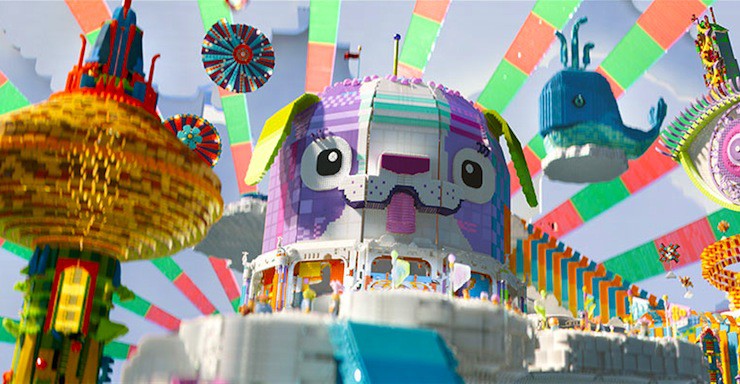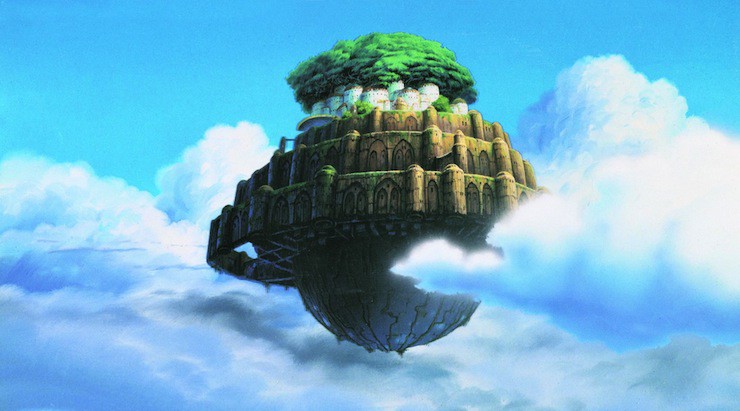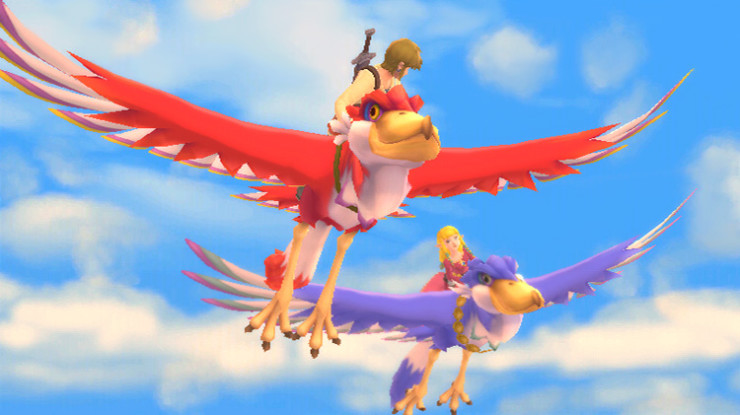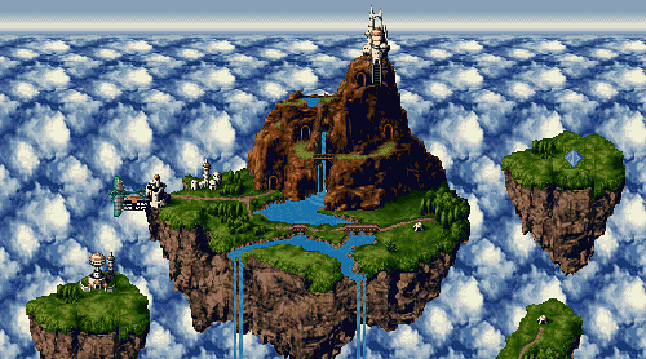From the realm of giants in Jack and the Beanstalk to the airborne habitats proposed by idealistic genius Buckminster Fuller, we’ve long been fascinated by worlds concealed above the clouds, set apart from the happenings on the ground. In discussing worldbuilding in the air, Updraft author Fran Wilde talks about what sky cities can represent: status, culture, control, or escape. With that in mind, we’ve compiled a list with some of our favorite cities—from books, movies, and video games—whose structures float in the air or rise high into the atmosphere.
Be sure to share your own favorite weird sky cities in the comments!
Mount Olympus and Cloud Cuckoo Land (Greek Mythology)
Olympus you’ve likely heard of: the tallest mountain in Greece, is serves as the seat of the ancient gods’ ruling class—the twelve Olympians were said to have palaces in gorges near the peak of the mountain, and they met together to discuss business (or, more often, to shout loudly at one another) on Pantheon, the highest point. In some accounts, the gods actually lived above Olympus, at the apex of a solid bronze dome that marked the edge of the sky, and the mountain served as their passageway to the mortal realm. In either case, the ancient Greeks likely never ventured to the pinnacle of the mountain, but would leave their offerings on lower peaks.
Then there’s Cloud Cuckoo Land, which was first introduced in Aristophanes’ satirical play The Birds: Fed up with Athenian life, the middle-aged Pisthetaerus persuades the world’s birds to create a new city in the sky. It turns out that the birds have been looking for just such an opportunity to create their own Mount Olympus and blockade the gods from receiving humans’ offerings. Cutting off their supply makes the birds the new gods, with Pisthetaerus benefiting as well. It’s no wonder that the term “cloud cuckoo land” has since been used to describe an absurdly over-optimistic fantasy. The LEGO Movie also nabbed the term for their wonderful mashup of all styles of building blocks, where the heroes rest as a safe haven from Lord Business and his need for perfectly-constructed LEGO worlds.
Bone Towers (Updraft)
In Fran Wilde’s forthcoming novel Updraft, towers of living bone pierce the clouds, creating a city whose inhabitants explore the skies in their gliders—and who must adhere to strict laws designed to protect against the many dangers hidden among the clouds. Getting one’s wings, as young Kirit yearns to, is a rite of passage. But when she accidentally breaks Tower Law, her punishment confines her to the Spire, the city’s tallest and most dangerous tower, and the mysterious training contained within. Wilde reminds readers and fellow authors of the key factors that differentiate sky cities from their counterparts on terra firma—namely, living by the whims of air currents and the constraints of gravity. She writes, “Setting a story in the air is a great opportunity to put your characters in jeopardy… and leave them there.”
Laputa (Gulliver’s Travels and Castle in the Sky)
Part III of Jonathan Swift’s adventuring epic Gulliver’s Travels sees the titular character rescued by the flying city of Laputa, whose denizens pursue art and science to no practical end whatsoever. (It was meant to be a satire of the experiments done by the Royal Society at the time.) Laputa was then revived by Hayao Miyazaki in the very first film ever produced by Studio Ghibli—Castle in the Sky. While the film was also an adventure story, the similarities between Miyazaki and Swift’s versions begin and end with the concept of a floating city where technology was used for political purposes: Swift’s Laputa saw citizens using their vantage point to throw rocks down onto rebellious cities below, while Miyazaki’s deserted Laputa is infiltrated by Muska, a member of one of the city’s old royal lines, who plans to use the advanced tech there for himself.
Moon’s Spawn (Malazan Book of the Fallen)
In the very first book of Steven Erikson’s Malazan series, Gardens of the Moon, the Malazan Empire has spent years unsuccessfully besieging Pale. The city has only held out for so long due to their alliance with a sky fortress known as Moon’s Spawn, commanded by the sorcerer Anomander Rake of Tiste Andii, a non-human species. Described as a ragged and blackened tooth, and the size of a mountain, the fortress was so notorious that even the undead army of Logros T’lan Imass were unwilling to assault its magical defenses. After Moon’s Spawn came under the combined attack of powerful mages, Rake withdraws his fortress, and Pale is lost.
Columbia (BioShock Infinite)
In an alternate, steampunk-y America, the floating city of Columbia was designed and founded by Zachary Hale Comstock as a “New Eden”—a utopia based on American political and religious ideals. Completed in 1893, the city was seen by the government as a means to promote American exceptionalism and scientific achievement around the globe, but Comstock had secretly included heavy armament, essentially creating a city-sized battleship. After an unauthorized attack on Chinese soldiers during the Boxer Rebellion, Columbia seceded from the U.S and disappeared above the clouds. Comstock retained complete control over the city’s government and enforced his own conservative social and religious vision, presenting himself as a divine prophet. It goes without saying that deviation from the state’s teachings is… unacceptable.
Oubliette (The Quantum Thief)
Hannu Rajaniemi’s sci-fi heist story centers on a floating Mars colony—well, technically it’s a platform that sits on the back of walkers attached to Mars’ surface, who occasionally walk the platform over to relocate it when needed. While the Oubliette began as a slave-labor latifundia (think of the space equivalent of a landed estate), the slaves who terraformed Mars’ surface eventually rebelled—leading to a war that unleashed the self-replicating phoboi plague. War forced the different entities to take turns maintaining the Oubliette, which has now become the sole human civilization left in the solar system.
Venus (and Other Planets) with Sky Cities

There are plenty of planetary environments that demand floating cities; if your surface is too hot, too cold, too hard to navigate, the easiest way to set up any kind of colony is to maintain it off the ground. (By sci-fi logic, at least.) Charlie Stross’ novel Saturn’s Children starts on a floating city on Venus, a perfect example of this trope. In Sly Mongoose, by Tobias S. Buckell, there are several sky-born habitats on Chilo—a Venus-like planet. (Buckell has said that Geoffrey A. Landis was responsible for the background on floating cities.)
We can readily find two more examples of this in well-known science fiction franchises. Star Wars features Cloud City, a suspended metropolis that hovers over the planet Bespin. The gas giant is home to a tibanna gas mining operation, and the substance covers the surface of the planet, so it stands to reason that any base of operations would have to exist in the sky. And then there’s the original series Star Trek episode “The Cloud Miners”: On the planet Ardana, sky-dwellers of the floating city Stratos gain untold privilege over the miners living on the surface because the mineral the laborers work so hard to obtain—zienite—releases a gas that is toxic and causes mental degeneration.
Tower of Babel (Tower of Babylon)
Countless stories and books have reinterpreted the Biblical archetype of a tower built by humans attempting to reach heights they have no business exploring. But Ted Chiang’s bizarre novelette sets the Tower of Babel within the geocentric model of Babylonian cosmology, where the earth is in the center of layers of celestial spheres. Here the builders are miners, trying to escape their little rock by tunneling up through the sky, hoping to break through the vault of heaven. The story follows a young miner from the town of Elam. As he ascends the tower, he uncovers mysteries of heaven and earth, and in the end finds them as inscrutable as ever.
Skyloft (Legend of Zelda: Skyward Sword)
BFFs Link and Zelda live on the main island of Skyloft, a chain of islands held aloft thanks to the powers of the Goddess Hylia, who generations earlier had launched the islands skyward to protect her people (and the sacred Triforce) from the demonic hordes that were overrunning the surface world. By the time the game begins, though, knowledge of the origins of Skyloft are lost to legend, and the surface world is obscured by a thick cloud layer. But as with any hero’s quest, the idyllic civilization comes under threat from the forgotten realm, and both Link and Zelda embark on parallel journeys to restore order.
Arianus (The Death Gate Cycle)
In the Death Gate Cycle by Margaret Weis and Tracy Hickman, the Earth is broken into four separate but interdependent worlds by the Sartan in an attempt to quell the threat of their rivals the Patryns. The air world of Arianus was to be an industrial world made up of floating continents, but the Sartan succumbed to an unknown disease; many died, and the survivors had to go into hibernation, awaiting aid from the other worlds. Without their guidance, the grand machine intended to stabilize the floating continents and provide them with water never became properly active. Instead, the dwarves effectively became slaves to the machine, worshiping it after a fashion as an artifact of their hibernating gods. The elves became tyrannical lords, manipulating the dwarves (and their machine) to obtain a monopoly on water, whilst constantly waging war with the humans.
Kingdom of Zeal (Chrono Trigger)
The heroes of Chrono Trigger time-hop all over the place, encountering a barren wasteland in the distant future and a dinosaur society at the dawn of time. But in the Age of Antiquity, they meet the elitist magic users of Zeal, a floating kingdom whose inhabitants used the power of Lavos to escape the icy surface world. Of course, the civilizations’ greed is their undoing—as they draw more and more power from the slumbering Lavos, the beast awakens and destroys the kingdom, sending it crashing back to the surface. Only a handful of survivors join the people already living on the inhospitable surface, but at least the massive impact of the falling islands seems to eventually change the world’s climate for the better…
Floating Continents of Lecythus (“Minla’s Flowers”)
Alastair Reynolds’ story envisions a world transformed by a civilizations’ attempt to save it. Diverted by technical difficulties to a planet known as Lecythus, space pilot Merlin finds himself forced to play a part in the moral and military dilemmas of a world on the verge of extinction—the remaining inhabitants of the world cling to floating continents formed by the shattered remains of a planet-wide defense system designed to camouflage them from outside attack. Spoiler alert: it failed. In the aftermath of the catastrophe, the broken world is in a constant state of civil war; Merlin urges peace, and reintroduces lost technology to the society in the hopes of repairing his ship and evacuating the doomed planet.














